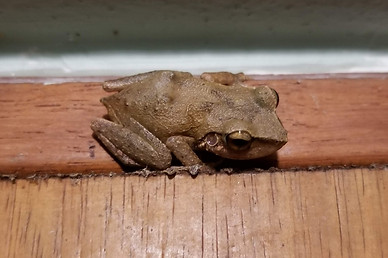


El Yunque
National Forest
El Yunque National Forest is the United State's only tropical rainforest. The forest is a lush wonderland of plants, animals, and its namesake mountain: El Yunque.
In it you can find the island's most prominent herbivore the snail, interesting insects, frogs and anoles, and tropical birds. Find out more about the forest and its fauna below, as well as ways you can help this natural paradise.

Get Involved!
Habitat loss and fragmentation cause a decrease in El Yunque and the wildlife that lives there. Rainforests are home to numerous animals, a place for medicinal research, and a carbon sink. However, the logging, farming, and ranching industries provide for many Puerto Rican families. This is a classic case of human/wildlife conflict that may not have a good solution.
If you feel passionate about finding a middle ground where the natural world can coexist with humans, check out this resource to learn about what you can do.
Get educated, teach others, and see that your impact is anything but small.
The Forest Levels

Cloud Forest
2,800 ft
150-200 inches of precipitation a year
65 degrees Fahrenheit
-
Soil is very shallow and acidic with poor drainage
-
Flora is somewhat short because of the heavy winds and rains
-
Lots of moss, lichen and first order streams

Sierra Palm Type Forest
2,500 - 3,000 ft.
90 - 100 inches of precipitation a year
<71 degrees Fahrenheit
-
This area levels out so there is less water
-
Soil is shallow and unstable

Palo Colorado Type Forest
2,000-2500 ft
100-180 inches of precipitation a year
>73 degrees Fahrenheit
-
Most prominent tree is the Palo Colorado
-
Home to the puerto rican parrot, flycatcher, and puerto rican hawk

Tabonuco Forest
<2,000 ft
70-100 in of precipitation a year
>73 degrees Fahrenheit
-
Soil is deep and well drained
-
Most prominent tree is the Candlewood
-
Waxy feeling, water resistant, and 33% of the canopy
-
Trees get most of their water from the air, not the roots
-
Fauna

Coqui Frog
Known as the national symbol of Puerto Rico, the Coqui frog can be found - and heard - everywhere. As the sun goes down, you can hear the males call their names to females "Co-kee!" More than 17 species of coqui are endemic to the island which means you can only find them here.
Although some species are doing fine, a few like the Coqui llanero are endangered on the island because of deforestation and urbanization.
Snail
You may be surprised to learn that the island's most abundant herbivore is the snail. With numerous species, this small resident covers trees in the Tabonuco level.
Because there are no large land predators in Puerto Rico, animals like the snail can flourish.


Anole
Anoles are small lizards in the suborder Iguania. They can be found climbing the trees and other surfaces in the rainforest. Males are identified by their colorful dewlap - extra skin from their neck that they use for mating and defending territory. There are many species of anole on the island ranging in sizes and colors.
An Island Symbol
A scary decline, a success story, and then, an unsure future...
The Puerto Rican Parrot: a symbol of the island's tenacity and spirit of never giving up. In the El Yunque National Forest, the last remaining species of parrot fights for survival despite habitat loss. Parrot biologists with the U.S Fish and Wildlife Survey work at aviaries to protect, breed and research the birds. When Hurricane Maria threatened the birds, the scientists bunkered down and protected 450 captive birds and searched for wild survivors.
Watch this documentary on an aviary's efforts after the hurricane by the University of Nebraska-Lincoln's student Isaiah Summers as part of the College of Journalism's Global Eyewitness program.
El Verde Field Station

Located deep in the heart of El Yunque National Forest, the El Verde Field Station conducts long-term research projects on the flora and fauna living in the rainforest.
Check out their website to learn more about their research.

